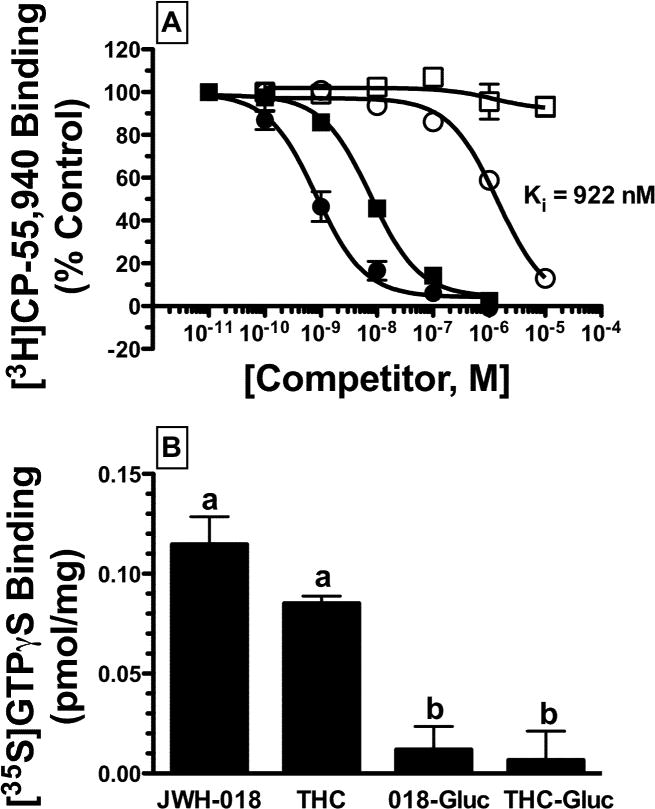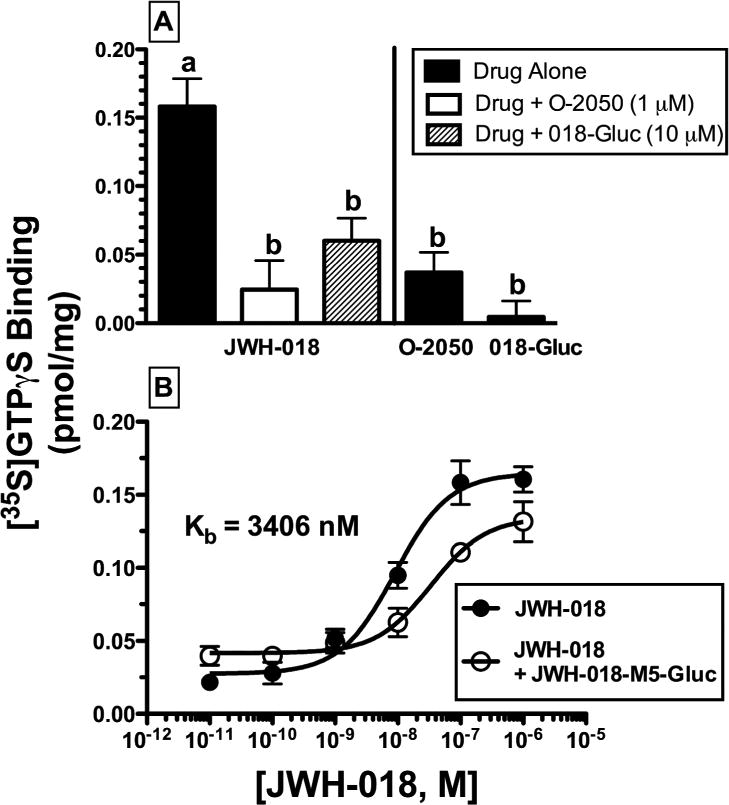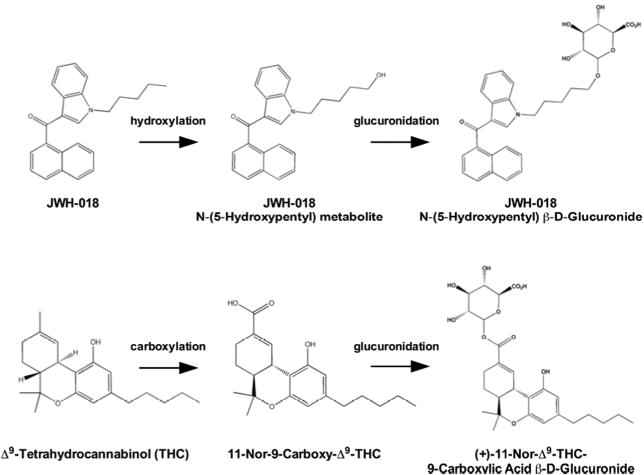Abstract
Recently, hydroxylated metabolites of JWH-018, a synthetic cannabinoid found in many K2/Spice preparations, have been shown to retain affinity and activity for cannabinoid type 1 receptors (CB1Rs). The activity of glucuronidated metabolites of JWH-018 is not known; hence this study investigated the affinity and activity of a major metabolite, JWH-018-N-(5-hydroxypentyl) β-D-glucuronide (018-gluc), for CB1Rs. The 018-gluc binds CB1Rs (Ki = 922 nM), has no effect on G-protein activity, but antagonizes JWH-018 activity at CB1Rs. The data suggests that hydroxylation by cytochrome P450s and subsequent glucuronidation by UDP-glucuronosyltransferases produces a metabolite, 018-gluc, which possesses antagonistic activity at CB1Rs.
On March 2, 2011 the U.S. Drug Enforcement Administration (DEA) temporarily classified five synthetic cannabinoids (JWH-018, JWH-073, JWH-200, CP-47,497, and cannabicyclohexanol) as Schedule I substances,1 but synthetic cannabinoid abuse is still increasing with more than 6,000 calls to Poison Control Centers in 2011,2 more than double the previous year. In addition, one in nine high school seniors admitted to using a synthetic cannabinoid in the past year.3 Little is known about the pharmacokinetics, metabolism, and toxicology of the synthetic cannabinoids other than their ability to induce psychoactive effects by activating one of the most abundant G-protein coupled receptors in the central nervous system, the cannabinoid type 1 receptor (CB1R).4, 5
Several published studies have investigated the metabolism and biological activity of various metabolites of the common synthetic cannabinoids JWH-018 and JWH-073.6-9 A number of hydroxylated metabolites of JWH-018 retain significant in vitro and in vivo activity.6 Since glucuronides of JWH-018 have been identified in vitro using recombinant UDP-glucuronsyltransferases (UGTs)7 and almost all of the JWH-018 metabolites are excreted in the form of glucuronides in human urine,8 studies investigating the biological activity of the glucuronide conjugates of JWH-018 are essential. This study investigated the activity and affinity of a major glucuronidated metabolite of JWH-018, a common constituent in K2/Spice, for the CB1R.
CB1R affinity was determined in [3H]CP-55,940 competition binding assays employing mouse brain homogenates. Consistent with previous reports6 JWH-018 and Δ9-tetrahydrocannabinol (THC) bind to CB1Rs with high affinities, 0.56 ± 0.22 nM and 8.0 ± 2.7 nM, respectively (Figure 1A). Importantly, a major glucuronidated JWH-018 metabolite JWH-018-N-(5-hydroxypentyl) β-D-glucuronide (018-gluc),7 which is excreted in human urine, binds to CB1Rs (Ki = 922 nM, Figure 1A). In contrast, a major glucuronidated THC metabolite (+)-11-Nor-Δ9-THC-9-carboxylic acid β-D-glucuronide (THC-gluc) does not bind CB1Rs (Ki > 10,000 nM). [35S]GTPγS binding using mouse brain homogenates examined the functional activity of these compounds at CB1Rs (Figure 1B). These studies revealed that JWH-018 and THC parent compounds exhibit agonistic activity at CB1Rs, as expected, maximally activating G-proteins (0.115 ± 0.016 pmol/mg and 0.085 ± 0.004 pmol/mg, respectively) when using 100 nM for JWH-018 and 1 μM for THC. In contrast, 10 μM of neither 018-gluc nor THC-gluc produced significant stimulation of G-protein activity (0.012 ± 0.014 pmol/mg and 0.007 ± 0.018 pmol/mg, respectively). Together, these data suggest 018-gluc lacks intrinsic activity, but retains receptor binding affinity. Thus, 018-gluc may function as a neutral antagonist at CB1Rs.
Figure 1.

Receptor binding and intrinsic activity of cannabinoids. JWH-018 (●) and THC (■) bind CB1Rs with nanomolar affinity (Panel A, n = 3). 018-gluc (○) binds to CB1Rs with nanomolar affinity (Ki = 922 ± 104 nM, n = 3) whereas THC-gluc (□) does not bind CB1Rs (Ki > 10,000 nM, n = 3). Panel B is the G-protein activity of JWH-018 (10-7 M, n = 4), THC (10-6 M, n = 5), 018-gluc (10-5 M, n = 3) and THC-gluc (10-5 M, n = 3) where different letters signify statistical differences between groups (P<0.05 by a one-way ANOVA with Newman-Keuls Multiple Comparison post-hoc test).
To determine if 018-gluc is an antagonist at CB1Rs, [35S]GTPγS binding studies were conducted to examine if 018-gluc antagonizes G-protein activation produced by the agonist JWH-018. In Figure 2A, a 10 nM concentration of JWH-018 produced stimulation of CB1R G-protein activation (0.137 ± 0.029 pmol/mg protein) in mouse brains homogenates. An established CB1R antagonist, O-2050,10 attenuated JWH-018-induced G-protein stimulation by 82.5% (0.024 ± 0.022 pmol/mg). Similarly, 10 μM of 018-gluc significantly antagonized JWH-018-induced G-protein stimulation by 56.3% (0.060 ± 0.018 pmol/mg, P < 0.05). Determination of the antagonist dissociation constant (Kb) for 018-gluc provided an additional quantitative measurement of antagonistic affinity of 018-gluc for CB1R by measuring the effect on G-protein activation produced by co-incubation with 10 μM of 018-gluc in the presence of increasing concentrations of JWH-018 (Figure 2B). A single 10 μM concentration of 018-gluc significantly shifted the JWH-018 curve 3.9-fold to the right (ED50 = 9.4 ± 1.6 nM to 37.0 ± 7.2 nM, P < 0.01) where the antagonist dissociation constant (Kb) of 018-gluc for CB1Rs is 3406 nM. Co-incubation with 018-gluc did not significantly alter the maximal level of G-protein activation (Emax) produced by JWH-018. Hence, data indicates 018-gluc, a major glucuronidated metabolite of JWH-018, may act as a neutral, competitive antagonist at CB1Rs in vitro.
Figure 2.

Antagonistic activity of 018-gluc. As shown in Panel A, JWH-018 (10-8 M, n = 6) is significantly antagonized by an established CB1R antagonist O-2050 (10-6 M, n = 3) and 018-gluc (10-5 M, n = 6). O-2050 and 018-gluc have no significant intrinsic activity at CB1Rs. Different letters indicate statistical differences between groups (P < 0.05 by a one-way ANOVA with Newman-Keuls Multiple Comparison post-hoc test).. In Panel B, a dose-response curve of JWH-018 (●, ED50 = 9.4 ± 1.6 nM, n = 3) is significantly shifted to the right during co-incubation of 10-5 M 018-gluc (○, ED50 = 37.0 ± 7.2 nM, n = 3, P<0.01 by Student's t-test). The Kb for 018-gluc determined by this method is 3406 nM.
As previously reported, hydroxylation of JWH-018 can produce several mono-hydroxylated metabolites that retain significant agonistic activity at CB1Rs in both in vitro and in vivo models.6 Glucuronidation by human UGTs of JWH-018 results in the formation of 018-gluc,7 a metabolite that retains affinity and activity as a neutral antagonist at CB1Rs. The preserved affinity of the 018-gluc for CB1Rs, unlike the major glucuronide of THC may be due to the metabolic placement of the glucuronide groups on the cannabinoid structure. For example, unlike the more rigid placement of the β-D glucuronide on the THC structure, the glucuronide of 018-gluc is positioned on the long akyl side chain that may allow the structure to remain flexible and retain the ability to bind the receptor (Figure 3).
Figure 3.

Hydroxylation or carboxylation of JWH-018 and THC with subsequent glucuronidation produces the β-D glucuronide derivatives.
While this potential mechanism requires further study, other reports support this notion by demonstrating the biological activity of JWH-018 and THC derived compounds depends on the positioning of new functional groups to the parent structure.11, 12 Notably, previous studies have established that the potency of THC-derivatives is influenced by long, alkyl side chains12 that may allow the structure to remain flexible and easily interact with CB1Rs.
Since the present results indicate that 018-gluc can antagonize the activity of the parent compound at CB1Rs in vitro, 018-gluc may attenuate the pharmacological properties of JWH-018 in vivo if sufficient concentrations are formed at the site of action. However, extrapolating these in vitro findings is difficult because the human pharmacokinetic properties and metabolism of JWH-018 is unknown. If metabolism of JWH-018 leads to antagonism of the psychoactive effects of JWH-018 in humans, escalated use of the parent compound is expected for achieving similar levels of intoxication. Further, if the half-life of 018-gluc is shown to be longer than JWH-018, chronic use of K2 or Spice products containing JWH-018 would be expected to potentially perpetuate abuse and may lead to increased levels of tolerance and dependence in relation to cannabis abuse. For example, a recent drug discrimination study conducted using monkeys where JWH-018 possessed the same discriminatory stimulus as THC, but the duration of psychoactive effects by THC were twice as long as JWH-018.13 The shorter duration of action of JWH-018 relative to THC may be due to the antagonism of JWH-018 by 018-gluc whereas THC-gluc lacks the ability to attenuate the effects of THC.
In summary, this study is the first to demonstrate that a major glucuronidated metabolite of JWH-018, a synthetic cannabinoid often found in K2 or Spice, acts as a neutral antagonist at CB1Rs in vitro. Future studies are required to determine if 018-gluc antagonizes the actions of JWH-018 in vivo.
Supplementary Material
Acknowledgments
The Authors would like to thank Krishna C. Chimalakonda, Stacie M. Bratton and Jessie S. Vanderhoof for their assistance while preparing this manuscript.
Funding Support: This work was supported by the Association of Public Health Laboratories [Grant Innovations in Quality Public health Laboratory Practice] (JHM), the Centers for Disease Control [Contract 200-2007-21729] (JHM), an award from the University of Arkansas for Medical Sciences Translational Research Institute, which is funded by the National Center for Research Resources [1 UL 1RR029884, Curtis Lowery, PI], and the National Institutes of Health [R01 GM075893] (AR-P).
Abbreviations
- 018-gluc
JWH-018-N-(5-hydroxypentyl) β-D-glucuronide
- THC-gluc
(+)-11-Nor-Δ9-THC-9-carboxylic acid β-D-glucuronide
- CB1Rs
cannabinoid type 1 receptors
- (UGTs)
UDP-glucuronsyltransferases
- THC
Δ9-tetrahydrocannabinol
Footnotes
Supporting Information. Experimental materials, methods and supplementary figures. This material is available free of charge via the Internet at http://pubs.acs.org.
Author Contributions: The manuscript was written through contributions of all authors.
References
- 1.Leonhart M. Schedules of controlled substances: temporary placement of five synthetic cannabinoids into schedule I. 2010:71635–71638. Federal Register. [Google Scholar]
- 2.AAPCC. Synthetic Marijuana Data. [accessed 17 December 2011];2011 www.aapcc.org.
- 3.Johnston LD, O MP, Bachman JG, Schulenberg JE. Marijuana use continues to rise amoung U.S teens, while alcohol use hits historical lows. University of Michigan News Service. 2011 www.monitoringthefuture.org.
- 4.Atwood BK, Huffman J, Straiker A, Mackie K. JWH018, a common constituent of ‘Spice’ herbal blends, is a potent and efficacious cannabinoid CB receptor agonist. Br J Pharmacol. 2010;160:585–593. doi: 10.1111/j.1476-5381.2009.00582.x. [DOI] [PMC free article] [PubMed] [Google Scholar]
- 5.Jarbe TU, Deng H, Vadivel SK, Makriyannis A. Cannabinergic aminoalkylindoles, including AM678=JWH018 found in ‘Spice’, examined using drug (Delta(9)-tetrahydrocannabinol) discrimination for rats. Behav Pharmacol. 2011;22:498–507. doi: 10.1097/FBP.0b013e328349fbd5. [DOI] [PMC free article] [PubMed] [Google Scholar]
- 6.Brents LK, Reichard EE, Zimmerman SM, Moran JH, Fantegrossi WE, Prather PL. Phase I Hydroxylated Metabolites of the K2 Synthetic Cannabinoid JWH-018 Retain In Vitro and In Vivo Cannabinoid 1 Receptor Affinity and Activity. PLoS One. 2011 doi: 10.1371/journal.pone.0021917. In Press. [DOI] [PMC free article] [PubMed] [Google Scholar]
- 7.Chimalakonda KC, Bratton SM, Le VH, Yiew KH, Moran CL, James LP, Moran JH, Radominska-Pandya A. Conjugation of JWH-018 and JWH-073 Metabolites by Human UDP-glucuronsyltransferases. Drug Metab Dispos. 2011 doi: 10.1124/dmd.111.040709. In Press. [DOI] [PMC free article] [PubMed] [Google Scholar]
- 8.Chimalakonda KC, Moran CL, Kennedy PD, Endres GW, Uzieblo A, Dobrowolski PJ, Fifer KE, Lapoint J, Nelson LS, Hoffman RS, James LP, Radominska-Pandya A, Moran JH. Solid-phase extraction and quantitative measurement of omega and omega-1 metabolites of JWH-018 and JWH-073 in human urine. Anal Chem. 2011 doi: 10.1021/ac201377m. In Press. [DOI] [PMC free article] [PubMed] [Google Scholar]
- 9.Moran CL, Le VH, Chimalakonda KC, Smedley AL, Lackey FD, Owen SN, Kennedy PD, Endres GW, Ciske FL, Kramer JB, Kornilov AM, Bratton LD, Dobrowolski PJ, Wessinger WD, Fantegrossi WE, Prather PL, James LP, Radominska-Pandya A, Moran JH. Quantitative Measurement of JWH-018 and JWH-073 Metabolites Excreted in Human Urine. Anal Chem. 2011;83:4228–4236. doi: 10.1021/ac201377m. [DOI] [PMC free article] [PubMed] [Google Scholar]
- 10.Wiley JL, Breivogel CS, Mahadevan A, Pertwee RG, Cascio MG, Bolognini D, Huffman JW, Walentiny DM, Vann RE, Razdan RK, Martin BR. Structural and pharmacological analysis of O-2050, a putative neutral cannabinoid CB(1) receptor antagonist. Eur J Pharmacol. 2011;651:96–105. doi: 10.1016/j.ejphar.2010.10.085. [DOI] [PMC free article] [PubMed] [Google Scholar]
- 11.Wiley JL, Marusich JA, Martin BR, Huffman JW. 1-Pentyl-3-phenylacetylindoles and JWH-018 share in vivo cannabinoid profiles in mice. Drug Alcohol Depend. 2011 doi: 10.1016/j.drugalcdep.2011.11.001. In Press. [DOI] [PMC free article] [PubMed] [Google Scholar]
- 12.Martin BR, Jefferson R, Winckler R, Wiley JL, Huffman JW, Crocker PJ, Saha B, Razdan RK. Manipulation of the tetrahydrocannabinol side chain delineates agonists, partial agonists, and antagonists. J Pharmacol Exp Ther. 1999;290:1065–1079. [PubMed] [Google Scholar]
- 13.Ginsburg BC, Schulze DR, Hruba L, McMahon LR. JWH-018 and JWH-073: {Delta}9-Tetrahydrocannabinol-Like Discriminative Stimulus Effects in Monkeys. J Pharmacol Exp Ther. 2012;340:37–45. doi: 10.1124/jpet.111.187757. [DOI] [PMC free article] [PubMed] [Google Scholar]
Associated Data
This section collects any data citations, data availability statements, or supplementary materials included in this article.


